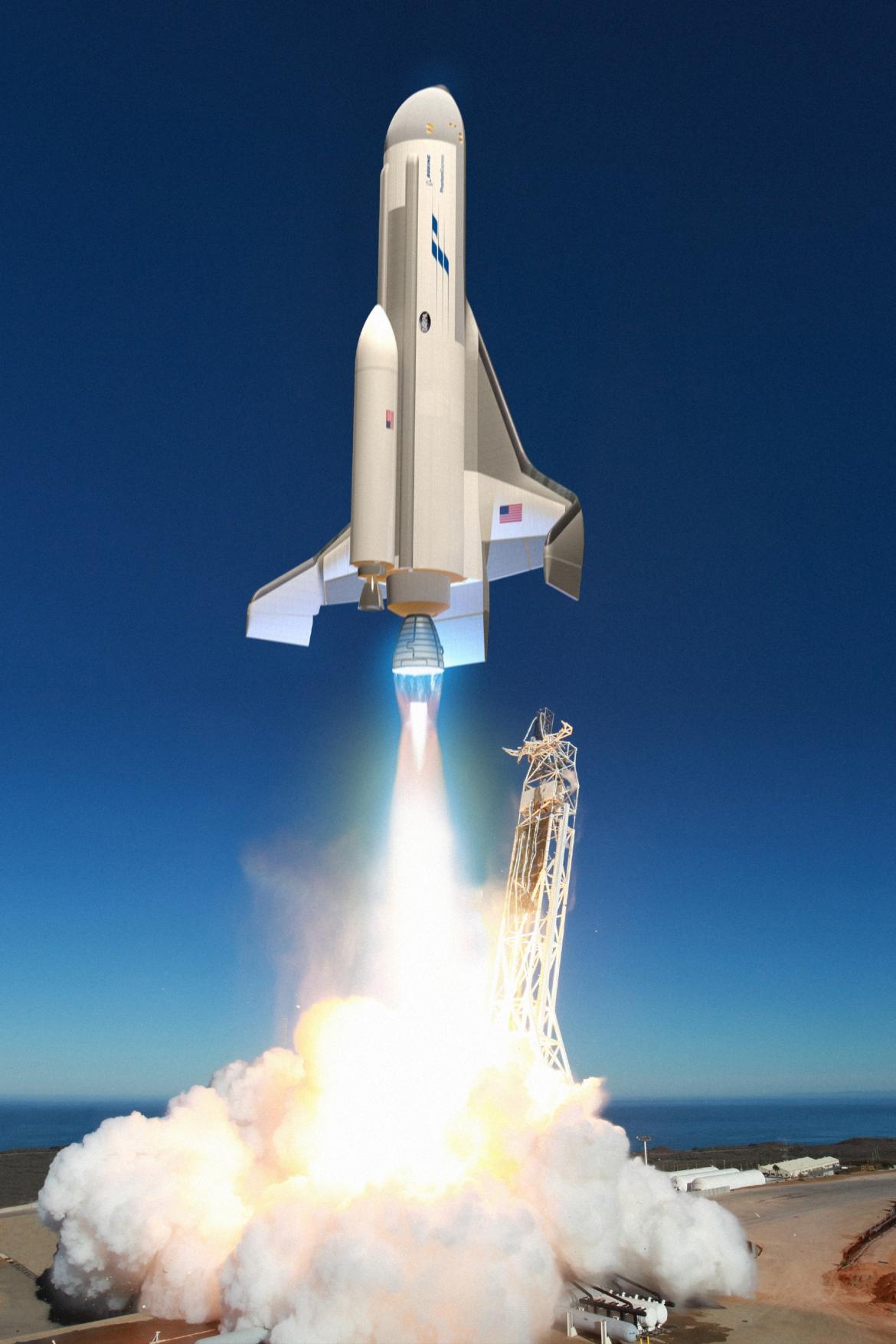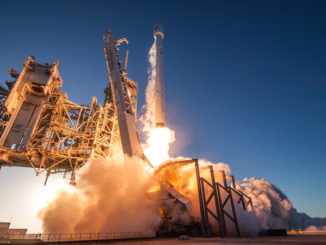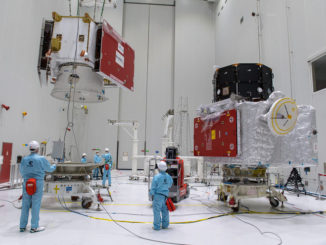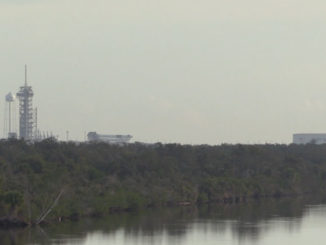After receiving more than $150 million in U.S. military funding to design and develop a reusable winged spaceplane named Phantom Express, Boeing said Wednesday it is ending its work on the vehicle, effectively killing a program military officials hoped would offer regular, reduced-cost launch opportunities for small satellites.
The Defense Advanced Research Projects Agency, or DARPA, announced Wednesday that Boeing informed the military of its intention to withdraw from the Experimental Spaceplane Program immediately.
Boeing won a $146 million funding agreement from DARPA in May 2017 to develop and fly the reusable spaceplane. The aerospace contractor partnered with Aerojet Rocketdyne to provide propulsion for the Phantom Express vehicle using a hydrogen-fueled AR-22 engine derived from engines flown on the space shuttle.
Boeing said in a statement Wednesday that the company decided to end its role on the Experimental Spaceplane Program, or XSP, “following a detailed review.”
“We will now redirect our investment from XSP to other Boeing programs that span the sea, air and space domains,” said Jerry Drelling, a Boeing spokesperson.
“We’re proud to have been part of a DARPA-led industry team that collaborated to advance launch-on-demand technology,” Drelling said in a statement. “We will make it a priority to harvest the significant learnings from this effort and apply them as Boeing continues to seek ways to provide future responsive, reusable access to space.”
Boeing’s decision effectively ends DARPA’s Experimental Spaceplane program, according to Jared Adams, a DARPA spokesperson.
“However, the objectives of the program remain of interest, and may be explored in separate efforts,” Adams said in response to questions from Spaceflight Now.
DARPA said it is negotiating the termination of Boeing’s agreement on the spaceplane program. The program was structured as a public-private partnership, with Boeing responsible for contributing private funding to support the development of the Phantom Express spaceplane.
The Experimental Spaceplane Program, formerly known as XS-1, started in 2013 to develop “an entirely new class of reusable launch vehicles, relevant to both civil and military sectors,” DARPA said in a statement.
“The program sought to develop a launch system with aircraft-like operability, including flying on demand, the ability to rapidly and cost-effectively turn the system around between flights, a low ground infrastructure footprint, and low recurring costs,” DARPA said.
The Phantom Express vehicle proposed by Boeing would have taken off vertically from a conventional launch pad, then release an upper stage at hypersonic speeds near the edge of space to accelerate into orbit. The upper stage would have been single-use and disposable, and the Phantom Express booster would have returned to Earth for a runway landing, ready to fly again on another mission.
DARPA previously said an end goal for the Experimental Spaceplane Program was to launch 10 times in 10 days, with recurring operating costs as little as $5 million per flight, including the disposable upper stage.
Boeing’s Phantom Works division led the Phantom Express project for DARPA. The Boeing team, supported by Aerojet Rocketdyne, won an agreement to work on Phases 2 and 3 of the Experimental Spaceplane Program in 2017.
At the time, DARPA and Boeing said the first Phantom Express technology demonstration vehicle could be completed in 2019 as part of Phase 2 of the program. In Phase 3, engineers planned to perform 12 to 15 flight tests beginning in 2020, first without payloads and at speeds as fast as Mach 5.
Then the spaceplane was to have flown to a speed of Mach 10 and release an upper stage carrying a small payload into low Earth orbit.
DARPA selected Boeing’s proposal in 2017 over bids from Northrop Grumman and Masten Space Systems, which participated alongside Boeing in the Phase 1 design phase of the Experimental Spaceplane Program. Northrop Grumman proposed partnering with Virgin Galactic on its spaceplane proposal, and Masten was working with XCOR Aerospace, a now-defunct company that had ambitions in the space tourism and propulsion market.
Boeing originally considering partnering with Blue Origin — Jeff Bezos’s space company — on the DARPA spaceplane project, but ultimately decided to go with Aerojet Rocketdyne as an engine supplier.

Financial information posted on a federal government procurement website show DARPA obligated more than $156 million in payments since 2014. The most recent payment to Boeing listed on the website was $34 million, which was obligated in September 2019.
The cost-sharing arrangement between Boeing and DARPA required industry to fund part of the project. The financial obligations listed on the federal contracting website suggest more than $100 million in “non-governmental dollars” were included in Boeing’s work on the spaceplane program.
The Phantom Express vehicle and its upper stage were designed to place up to 3,000 pounds (1,360 kilograms) of payload into low Earth orbit, serving a market segment between the class of commercial small satellite launchers developed by companies like Rocket Lab and Virgin Orbit, and heavier boosters operated by SpaceX and United Launch Alliance.
According to a Boeing website, the Phantom Express spaceplane was to be about the size of a business jet, measuring about 100 feet (30.5 meters) long, with a height of 24 feet (7.3 meters), a diameter of 13.7 feet (4.1 meters), and a wing span of 62 feet (19 meters).
The Phantom Express was expected to lift off from a new launch complex to be constructed at NASA’s Kennedy Space Center in Florida. Sized for small rockets, Launch Complex 48 is slated to be built between launch pad 39A at KSC and pad 41 at Cape Canaveral Air Force Station.
The spaceplane would have landed back at Cape Canaveral after sending its upper stage toward space, returning to runway landings at Kennedy’s Shuttle Landing Facility or the Skid Strip at Cape Canaveral Air Force Station.
Engineers test-fired an AR-22 engine 10 times in 10 days in mid-2018 to demonstrate the engines rapid turnaround capability for the Phantom Express vehicle. Assembled from leftover parts from the space shuttle program and NASA’s Space Launch System, the AR-22 engine ignited on a test stand at NASA’s Stennis Space Center for the daily test-firings.
Boeing said in November 2018 that it had completed fabrication of a composite liquid oxygen cryotank for the Phantom Express spaceplane at the company’s Advanced Developmental Center in Tukwila, Washington.
The detailed engineering activities conducted under the Experimental Spaceplane Program affirmed that no technical showstoppers stand in the way of achieving DARPA’s objectives, and that a system such as XSP would bolster national security,” DARPA said in a statement. “Through XSP, DARPA identified evidence that present-day liquid rocket propulsion systems are capable of supporting XSP objectives.”
DARPA said the program yielded data on a liquid-fueled rocket vehicle configuration that could operate like an airplane, and on missions that could use a system like the Phantom Express. Other accomplishments included studies of the dynamics of deploying an upper stage carried into space with a spaceplane, and the design and fabrication of “linerless” composite tanks for cryogenic propellants.
The agency said it also developed a “concept roadmap” for different flight systems based on technology developed for the Experimental Spaceplane Program.
The Experimental Spaceplane Program is the second DARPA satellite launch initiative with Boeing as a partner that ended before a flight demonstration.
DARPA’s Airborne Launch Assist Space Access, or ALASA, program was canceled in 2015. The ALASA effort — developed with Boeing as a prime contractor — intended to launch 100-pound (45-kilogram) satellites into orbit on a rocket fired from the belly of an F-15 fighter jet.
But DARPA canceled the program in 2015 after running into problems testing the rocket’s mix of nitrous oxide and acetylene fuel, a “monopropellant” cocktail that would have eliminated the need for the launcher to carry an oxidizer.
Email the author.
Follow Stephen Clark on Twitter: @StephenClark1.



